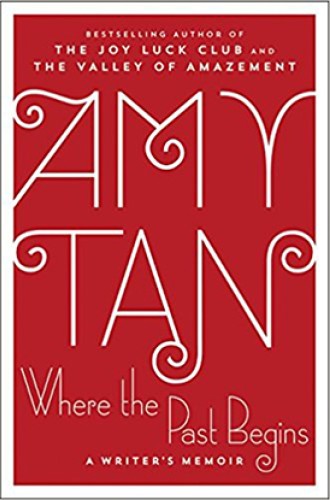Amy Tan on writing, family, and writing about family
Some parents are horrified when their children write books that air family secrets. Not Daisy Tan.
Early in this book’s gestation, Amy Tan thought to call it The Story Behind the Story. That title, though ultimately discarded, is apt in two senses: Tan makes explicit how thoroughly her mother’s and grandmother’s lives saturate her novels, and—for readers more curious about the creative process than about Tan’s family—she examines how the writing life works.
Because much of Tan’s fiction is autobiographical, those two registers are inseparable: to write about writing is, for Tan, to write about her forebears. Tan’s mother, Daisy, whose own mother killed herself to escape life as a rich man’s concubine, married a violent, wealthy cad. She eventually abandoned him and their three daughters, moving from China to America to marry the man who would become Tan’s father. Tan’s first novel, The Joy Luck Club, drew so evocatively on the family’s matriarchal lore that Daisy wondered if her own long-dead mother had visited Tan and helped her with it.
Read our latest issue or browse back issues.
But Where the Past Begins does more than rehearse Tan’s harrowing ancestral tales. Recalling Alison Bechdel’s exploration in Are You My Mother? of the frictions and intimacies between a mother and a writer-daughter, Tan considers her fiction as almost a third character in her complicated relationship with her mother. Some parents are horrified when their children write novels moored in family secrets. Not Daisy Tan. Shortly after The Joy Luck Club was published, recalls Amy Tan, a relative
complained to my mother that she should not be telling me all these useless stories. “She can’t change the past,” he said. My mother told him: “It can be changed. I tell her so she can tell everyone, tell the whole world, so they know what my mother suffered. That’s how it can be changed.” My mother . . . wanted the secrets exposed so that the power of shame could be replaced with outrage.
Tan’s novels gave her mother something otherwise unavailable: a “conduit for her woes,” as Tan puts it—a channel for grief that would, without it, have remained dammed. Tan admits that she didn’t always enjoy being her mother’s repository; sometimes she wanted to stop listening and get back to her writing desk.
Tan’s father, an engineer by trade and Baptist pastor by vocation, who died when Tan was 16, is less central to the memoir. He figures most prominently in a chapter in which Tan wonders how he would have voted in the 2016 election. As an evangelical Christian, would he have supported Trump? Tan searches her father’s papers for clues. This chapter, like much of the book, is beguilingly layered. Tan blends past and present, research and memory, in her effort to infer what a long-dead half-remembered parent might do now.
But the portrait she paints of her father’s Christianity is two-dimensional. She criticizes him for praying for sick friends without asking about their feelings or offering to help. And she writes that his faith was based on fear: “To fear God is to love God—that’s what many evangelicals believe.” Tan’s relieved conclusion—that had he lived, her father “would have voted for better” because he was an immigrant and because his wife felt strongly about “a woman’s right to choose”—seems faintly condescending. Tan the writer (who knows about Tan the daughter?) seems to find empathy for her character only by imagining a future in which he develops along lines that converge with hers.
Most of Tan’s ruminations about her parents are expertly mortised to reflections on writing novels. Although Tan insists she’s not aiming for “self-psychoanalysis” when she sits at her computer, Where the Past Begins implicitly suggests that writing has an almost psychoanalytic power. Not least, it helps you remember.
Tan recounts being told by a teacher to write about a time she thought she would die. At first, she wrote about skiing a slope she couldn’t handle. Prodded by the workshop leader to “think harder” and land on a time you “really thought you were going to die,” Tan turned up a collegiate car wreck. Pressed by the instructor to go yet further, she found her mother trying to kill her with a meat cleaver when she was 16. The event was so alien to her consciousness that Tan wondered if she’d invented it—until her mother “confirmed it . . . without any remorse.”
Tan demonstrates that even the most autobiographical fiction writing makes possible something more than mere catharsis. To write a story, “a laborious and confounding experience tantamount to conducting an orchestra of ghosts and being the caterer for a wedding reception full of thieves and drunks,” the writer must lose self-consciousness. She’s thereby freed (and, indeed, required) to explore connections among events and find in them a narrative in a way that the writer’s conscious everyday mind—as a matter of survival—prohibits.
Tan isn’t the first novelist to write a memoir laced with wisdom about writing. In a classic of the genre, One Writer’s Beginnings, Eudora Welty notes that “the author . . . writes at his own emergency.” Welty means that the writer writes at the location of her emergence into being a person (and a writer). Reading Tan, I found myself thinking of another meaning (which was not, I think, intended by Welty): the writer writes at the site of her own urgency, her own pressing need.
Tan is especially good on urgency. She’s good at conveying the subterranean urgencies of families (as is Welty), and she’s good at theorizing urgency. “Urgency and tension,” she observes at one point, are needed to make the writing flow. All the better when what is urgent for the character on the page intersects with what’s urgent for the woman doing the writing. Where the Past Begins brings together the two senses of emergency: it’s precisely in those urgent spaces that the writer finds her emergence into self and writer.







